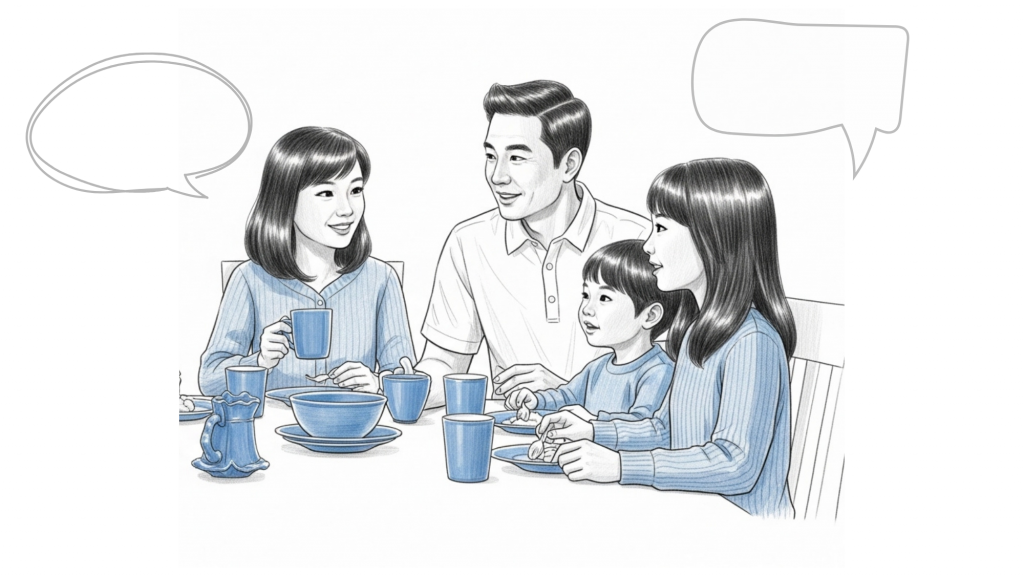What if your child could learn simply by talking with you — no worksheets, no special resources, just real conversations that matter? Learning through conversation encourages children to think deeply, ask questions, and develop confidence, reasoning, and communication skills. This approach can boost confidence, improve social skills, and make learning more enjoyable and meaningful.
For home educating families, learning through conversation fits perfectly. It’s one of the oldest ways of teaching — even the ancient Greeks used it! You just need to ask questions, listen to your child, and have real discussions about things that matter to them. This turns learning into a natural part of family life, rather than something that only happens during “lesson time.”
Why It Works
Learning through conversation is effective because it builds on what children already know. You can use it mid-way through a topic or unit to check understanding and help them think more deeply. Conversations like this can happen anywhere — in the car, over dinner, on walks, or while shopping.
It works best in small groups — a home ed group, family dinner, or online discussion. You can also use it one-on-one. Tools like our Dinner Time Discussion cards provide a starting point, but once you get into the rhythm, this approach takes very little preparation.
The Educational Theory Behind It
For parents who want to understand the theory, learning through conversation draws on Lev Vygotsky’s Zone of Proximal Development (ZPD). The ZPD is the space between what a child can do alone and what they can do with guidance. Using dialogic scaffolding — asking open questions, gently guiding, and helping children respond to others’ ideas — supports learning in this zone. This is where children grow the most, building skills while feeling supported.
How to Model Good Talk
Children learn by watching adults. You can model good discussion habits with phrases like:
- Acknowledge: “I see what you mean.”
- Build: “I’d like to add to that…”
- Challenge kindly: “I think something different because…”
- Summarise: “So far, we’ve got two different ideas…”
At first, you will guide most of the discussion. As children gain confidence, encourage them to ask questions and respond to each other. This is a key part of learning through conversation.
The CLEAR Framework for Learning Through Conversation
The CLEAR Ladder gives you a simple way to develop and challenge your child’s thinking through structured conversation.
C – Clarify
- “What do you mean by [key term]?”
- “Can you give me an example?”
- “Can you explain that in your own words?”
- “What do you notice about…?”
L – Look for Reasons
- “Why do you think that?”
- “What makes you sure?”
- “What evidence supports this?”
- “Where did this idea come from?”
E – Explore Alternatives
- “Could there be another explanation?”
- “What would happen if we looked at it differently?”
- “How might someone else in another time or place think about this?”
- “What’s the opposite point of view?”
- “What else might be true?”
A – Apply & Analyse
- “How does this connect to what we learned before?”
- “Can you think of an example from everyday life?”
- “What would happen if we tried this in real life?”
- “Does this remind you of something else?”
- “What could this idea help us understand?”
R – Reflect & Review
- “What’s the most important thing you’ve realised?”
- “Did your thinking change today?”
- “What do you still wonder about?”
- “What did you learn from someone else’s idea?”
- “If you had to explain this to a younger child, how would you do it?”
Example: Learning Through Conversation with Literature
Starter Question:
“Why does Macbeth choose to murder King Duncan?”
C – Clarify
- “Can you give an example from the text that shows Macbeth’s thinking?”
- “Can you explain in your own words what Macbeth is feeling?”
- “What do you notice about how other characters react to Duncan’s murder?”
L – Look for Reasons
- “Why do you think Macbeth makes this choice?”
- “What makes you sure that ambition is the main reason?”
- “What evidence in the text supports your idea?”
E – Explore Alternatives
- “Could there be another reason Macbeth commits the murder?”
- “What’s the opposite viewpoint — that Macbeth was forced by fate?”
A – Apply & Analyse
- “Can you think of a modern situation where someone is tempted to act unethically?”
- “What would happen if Macbeth had made a different choice?”
- “What can studying Macbeth teach us about human behaviour?”
R – Reflect & Review
- “What’s the most important thing you’ve realised about Macbeth’s character?”
- “Did your thinking change after considering other reasons or influences?”
Final Thoughts
Learning through conversation makes everyday interactions into meaningful educational experiences. By asking questions, listening carefully, and following the CLEAR Ladder, parents can help children think deeply, reason clearly, and make connections across subjects. With practice, learning through conversation becomes a natural, engaging, and rewarding part of family life — wherever and whenever you choose to do it.

